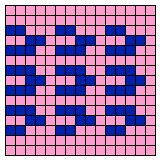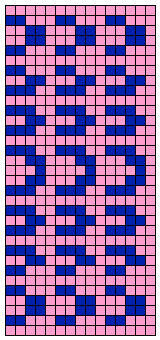Difference between revisions of "Ants"
m (templatified links) |
(→Longitudinal period 5 de Bruijn diagram: File:ANTSW5.PNG belongs to here) |
||
| Line 15: | Line 15: | ||
{| | {| | ||
|- | |- | ||
|[[Image:SEDON5.PNG| | |[[Image:SEDON5.PNG|thumb|eight nodes encompass possible ant sections]] | ||
|[[Image:FIGLW5.PNG| | |[[Image:FIGLW5.PNG|thumb|de Bruijn diagram defining an ant grammar]] | ||
|[[Image:MYRLW5.PNG| | |[[Image:ANTSW5.PNG|thumb|width 5 longitudinal de Bruijn diagram]] | ||
|[[Image:MYRLW5.PNG|thumb|sample path with the zero node at both ends]] | |||
|} | |} | ||
| Line 28: | Line 29: | ||
Making the excursion EA, returning via BD, creates an intermixture wherein the classical ants can travel amongst ants from the right side, short legs alongside each other. Altogether any path through the diagram generates a phalanx of ''ants'' whose spatial period is 5 and which advance longitudinally one cell per generation - at light speed, if one wishes to say so. | Making the excursion EA, returning via BD, creates an intermixture wherein the classical ants can travel amongst ants from the right side, short legs alongside each other. Altogether any path through the diagram generates a phalanx of ''ants'' whose spatial period is 5 and which advance longitudinally one cell per generation - at light speed, if one wishes to say so. | ||
In practice, an ant stream might terminate on the left, creating a [[wick]]; it is also possible to realign ants vertically. It requires transversal de Bruijn diagrams, and diagrams of different spatial periodicities to encompass all these variants; here we have examined only the one special case to show that ants can be foreseen, and that they occur in a large variety which nevertheless can be enumerated. | In practice, an ant stream might terminate on the left, creating a [[wick]]; it is also possible to realign ants vertically. It requires transversal de Bruijn diagrams, and diagrams of different spatial periodicities to encompass all these variants; here we have examined only the one special case to show that ants can be foreseen, and that they occur in a large variety which nevertheless can be enumerated. | ||
==Quadfuse== | ==Quadfuse== | ||
Revision as of 09:27, 14 May 2020
| Ants | |||||||
| View animated image | |||||||
| View static image | |||||||
| Pattern type | Wick | ||||||
|---|---|---|---|---|---|---|---|
| Period | 5 | ||||||
| Speed | c | ||||||
| Discovered by | Unknown | ||||||
| Year of discovery | Unknown | ||||||
| |||||||
Ants is a period 5 wick with standard form shown to the right. Beyond the standard form, there is a wide variety of other ants because that is a general form of patterns moving orthogonally, one cell per generation. For example, it is also possible for any ant to be displaced by one or two cells relative to either or both of its neighbouring ants. Dean Hickerson found fenceposts for both ends of this wick in October 1992 and February 1993.
Ants can be either wide or narrow while still maintaining the spatial (and hence temporal) periodicity 5; but they can also be much longer yet still retaining the same style of movement. There is a grammar, derived from de Bruijn diagrams, succintly encompassing the alternatives.
Longitudinal period 5 de Bruijn diagram
This de Bruijn diagram has two major subdiagrams. On the left, the cycle ABC generates the classical ant stream. A detour through the self loop at Z provides parallel streams with arbitrary vertical spacing, which is possible because the ant's legs are only of length 2. The yellow box indicates a slip line along which adjacent streams could be displaced.
The linkage between cycles on the right side of the diagram is more complicated. Streams containing ants with legs of length three (or more) need a guard rail separating them, which is provided by the self loop at node G; taken by itself it generates the Zebra stripes agar. Equally with the free space, this node generates slip lines.
The loop DE taken in that order generates 4x3 ants which can snuggle next to each other without the guard rail, although DGE can include it every now and then. Including node F in the cycle yields the head of a 4x5 ant which requires the legs of the ant to its right to guide it.
Making the excursion EA, returning via BD, creates an intermixture wherein the classical ants can travel amongst ants from the right side, short legs alongside each other. Altogether any path through the diagram generates a phalanx of ants whose spatial period is 5 and which advance longitudinally one cell per generation - at light speed, if one wishes to say so.
In practice, an ant stream might terminate on the left, creating a wick; it is also possible to realign ants vertically. It requires transversal de Bruijn diagrams, and diagrams of different spatial periodicities to encompass all these variants; here we have examined only the one special case to show that ants can be foreseen, and that they occur in a large variety which nevertheless can be enumerated.
Quadfuse
On January 10, 1994 it was noticed by Alan Hensel that if a single cell is removed from the back end of the trailing ant, it becomes a fuse with the peculiar property that its burning reaction grows quadratically.[1] This reaction is known as the quadfuse.
See also
References
- ↑ Jason Summers' jslife oversize pattern collection. Retrieved on May 19, 2009.
External links
- Ants at the Life Lexicon




